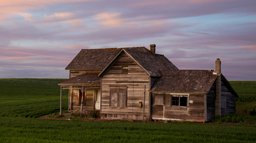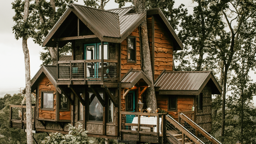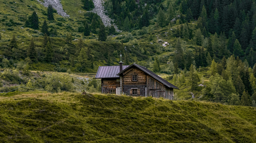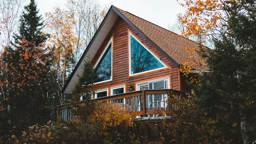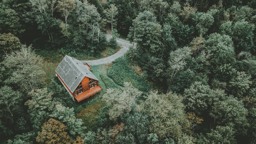
The question of when to bite the bullet and replace something that you’ve been nursing for months or years is a tough one. It’s an even more pressing concern when your cabin is your permanent home or sees frequent use. Yet, no one likes to write checks of the size that often accompany a replacement project, especially if the cabin is only an occasional retreat. So how do you decide when the time has arrived?
One approach is to track repair costs until they near the cost of a replacement. For example, it may take 10 years of $100-$200 “house calls” from an HVAC company to equal the cost of replacing an aging heat pump or furnace. Then again, a new unit may require an annual visit, so the true added cost of maintaining the old unit isn’t as great as it might at first seem. As long as the visits don’t become more frequent or more costly, maintaining the old unit may be a reasonable alternative. However, if your cabin is a year-round residence, you also want to consider the impact should the unit decide to stop working altogether. In my part of the world, where winter temperatures may hit minus 30°F and stay there for some time, I would not nurse along an unreliable furnace.
Hot, cold; wet, dry
Mechanical systems such as heating, cooling, ventilation and hot water equipment usually see prolonged heavy use. No matter how careful you are, they eventually wear out. The advice of a reliable HVAC contractor or plumber can be invaluable in deciding when repair is no longer a good investment. Also, equipment that is 5 years old or more may be obsolete. Rapid advances in energy efficiency and more stringent energy codes have resulted in marked improvements. As a result, you may be able to recoup replacement costs quickly through reduced energy consumption and reduced maintenance.
Natural gas and propane equipment and appliances also present potential safety issues. Older units often used combustion air drawn from inside your home and exhausted to the outside through a passive vent. Sealing air leaks in your home can starve such appliances of air needed for complete burning. The result is life-threatening carbon monoxide. If you have older gas appliances and plan to air seal or tighten your home, consider either replacing older passive-vented gas appliances or having mechanical venting and air intakes installed. Conversely, direct-vent units are sealed, keeping intake air and exhaust gases completely separated from room air.
Wooden structures
Mechanical systems are only one area of your cabin needing vigilance. Wood, especially if allowed to remain wet, is always susceptible to decay. Periodic inspections of porches, decks, wood siding and exterior trim afford the best protection. Paint, caulk and sealant are usually do-it-yourself repairs. More advanced cases of decay may require epoxy wood filler. But when decay becomes structural, it’s usually best to call in a specialist.
Replacing structural components such as porch and deck supports or roof or wall framing requires an understanding of how structures work. Removing a damaged support post without accounting for the weight that it is bearing can be dangerous. Be proactive when it comes to replacing structural components such as support posts, concrete foundation walls, and framing. The damage that can result from waiting can be very costly to correct.
See also Maintaining Your Cabin Exterior
Roof revival
Most cabins will face a roof replacement at some point in their lives. Three-tab shingles, even in a good environment, typically have a lifespan of no more than 15–18 years. In a cabin tucked under a thick canopy of trees in a moist climate or in the direct sun of a dry or desert climate, consider anything more than 10 years a gift. Metal, tile and slate roofs will last many decades. While they cost more initially, they won’t saddle you with a periodic, large cash outlay.
Telltale signs will warn you when shingle roof-replacement time has arrived. Gutter bottoms will be covered with the fine particles that coat shingles; the shingles will curl or seem brittle; and patches of roof will remain dark and damp looking after a rain. All are indicators that the roof has lost much of its protective ability. If the roof has only its original shingle layer, a second layer can usually be placed directly over the top. If the roof already has two layers, both layers will have to be removed before the new shingles can be installed.
While one of the most common projects, roof replacements are often delayed sometimes to the point of causing a need for additional repairs. When a shingle roof fails, visible signs of damage may be hard to spot. Water penetrating the shingles can dampen roof sheathing and cause it to rot. Roof edges may start to decay and water seepage into the attic space can cause framing to deteriorate – all without any directly visible symptoms. For this reason, it’s best to be proactive with your roof and replace it sooner rather than later.
Window Inspection
Good quality windows made in the last 20 years can have a long lifespan. Before you replace older wood sash windows, consider their condition. If the windows are in good shape and operate well, then adding a storm window may be a less expensive alternative than replacement. Not only will the upgrade improve energy efficiency, it will preserve the character of the original windows. But when windows stop operating and the wood shows decay, replacement is often a better and less expensive option than repair.
Jim Cooper knows his stuff. A former home builder and general contractor, he is author of “Log Homes Made Easy” and “The Log Home Project Planner.” Also, he is a LEED Accredited Professional and Certified Passive House Consultant.
See also The Importance of Maintenance and Resourcefulness at the Cabin




